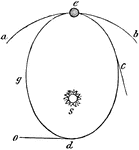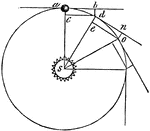Clipart tagged: ‘herschel’

Elliptical Orbit
"The elliptical circle being supposed to be the Earth's orbit, with the Sun, S, in one of the foci.…

Planet Distance
"Relative distance of the Planets. Having now given a short account of each planet composing the solar…

Planet Motion
"Elliptical Orbits.—It has been supposed that the Sun's attraction, which constitutes the Earth's…
!["These telescopes were all reflectors; that is, instead of looking up at a star through a tube with a glass in the upper end [Herschel] would look down into the tube away from the star and see its reflecting in a concave mirror at the lower end of the tube."—The Foundation Library, 1911](https://etc.usf.edu/clipart/79400/79403/79403_telescope_mth.gif)
A Great Reflecting Telescope
"These telescopes were all reflectors; that is, instead of looking up at a star through a tube with…


